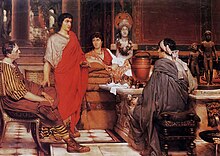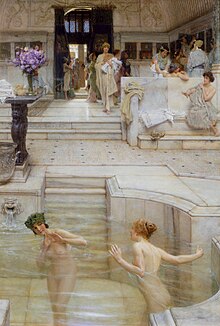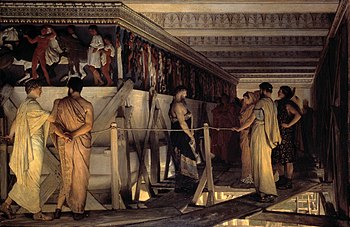Lawrence Alma-Tadema
Sir Lawrence Alma-Tadema , OM , RA (birth name: Lourens Alma Tadema , born January 8, 1836 in Dronrijp , Netherlands ; † June 25, 1912 in Wiesbaden ) was a Dutch painter and draftsman of academic realism with British , Belgian and Dutch citizenship .
Life
Alma-Tadema was the third child of the notary Pieter Jiltes Tadema and his second wife Hinke Dirks Brouwer (the half-sister of the first woman). He received his first name Lourens Alma after his godfather; later he made Alma part of his surname in order to appear at the beginning of exhibition catalogs.
Alma-Tadema's father died in 1840 and he was given a guardian. At the age of 16 Alma-Tadema came to Antwerp in 1852 and was a student of Gustave Wappers at the art academy there . With his advocacy, he was later able to move to Hendrik Leys' studio and became his assistant. In 1859 Alma-Tadema helped Leys decorate the city hall of Antwerp. Alma-Tadema worked as a freelance artist for the next few years, but was repeatedly found as a student in the studios of Josephus Laurentius Dyckmans or Gustave Wappers.
In 1863 Alma-Tadema married Pauline Gressin, a French woman, in Antwerp and lived with her in Brussels until her death in 1869 . In 1864 a picture of him was awarded a medal at the Salon de Paris exhibition in 1864. At the world exhibition in Paris in 1867 , his exhibited works were also awarded prizes. With his two daughters Laurence and Anna , Alma-Tadema settled in London in 1870 and devoted himself to history painting in the following years , repeatedly finding his subjects in antiquity. In 1871 Alma-Tadema married Laura Theresa Epps in London, who came from a family of artists and who also made a name for herself under the name Laura Theresa Alma-Tadema . Queen Victoria , who held Alma-Tadema in high esteem , granted him permanent residence ( denization ) in 1873 , since otherwise, as a foreigner, he would not have been allowed to become a member of the Royal Academy of Arts .
In 1876 the Royal Academy of Arts accepted Alma-Tadema as an "Associate" and only three years later they made him a full member. The prestigious Grosvenor Gallery in London honored him in a highly regarded exhibition. On the occasion of Queen Victoria's 81st birthday in 1899, Alma-Tadema was promoted to Knight Bachelor and from then on bore the suffix "Sir".
Sir Lawrence Alma-Tadema died at the age of 76 on June 25, 1912 in Wiesbaden and was buried in St Paul's Cathedral in London.
The pictures of the Victorian painter Alma-Tadema are characterized by a special level of detail that made him one of the most famous painters in Great Britain during his lifetime. The Academy Berlin , Academy of Fine Arts, Munich , Royal Academy of Madrid and the Academy of Fine Arts Vienna adorned themselves with its membership. In 1902 he was accepted as a foreign member of the Académie des Beaux-Arts .
Lawrence Alma-Tadema was the cousin of Hendrik Willem Mesdag .
Honors

- Pour le mérite for science and arts (1881)
- Belgian Order of Leopold , knight
- Knight of the Bavarian Order of Saint Michael
- Knight of the French Legion of Honor
- Order of Merit
- Member of the Royal Academy of Arts
Works (selection)
- Egyptians 3000 Years Ago , ( Egyptians 3000 years ago , 1863), Harris Museum and Art Gallery, Preston, UK
- An Egyptian at his doorway , ( An Egyptian at his doorway , 1865)
- The mummy , ( The mummy , 1867)
- Der Kammerherr des Sesostris , ( The chamberlain of Sesostris , 1869)
- An Egyptian Widow , ( An Egyptian Widow , 1872), Rijksmuseum , Amsterdam
- The death of the firstborn , ( The Death of the First Born , 1873), Rijksmuseum, Amsterdam
- An Audience with Agrippa , ( An Audience at Agrippa’s , 1876), private collection
- Autumn: Harvest Festival ( Autumn: Vintage Festival , 1877), Birmingham Museum and Art Gallery, Birmingham
- Sappho and Alkaios , Sappho and Alcaeus (1881), Walters Art Museum , Baltimore, USA
- The Way to the Temple , ( The Way to the Temple , 1883), Royal Academy of Arts , London
- Portrait of Leopold Löwenstam , 1883, private collection
- The Women of Amphissa , ( The Women of Amphissa , 1887), The Clark Institute, Williamstown, USA
- Die Rosen des Heliogabalus , ( The Roses of Heliogabalus , 1888), private collection
- A Favorable Point of View , ( Coign of Vantage , 1895), private collection
- Finding of Moses , ( The Finding of Moses , 1904), private collection
- A preferred practice , ( A Favorite Custom , 1909), private collection
literature
- Rosmary J. Barrow: Lawrence Alma-Tadema . Phaidon Press, London 2003, ISBN 0-7148-4358-X
- Edwin Becker (Ed.): Sir Lawrence Alma-Tadema . Rizzoli, New York 1997, ISBN 0-8478-2001-7
- Vern G. Swanson : The biography and catalog raisonné of the paintings of Sir Lawrence Alma-Tadema . Garton & Co, London 1990, ISBN 0-906030-22-6
- Hans Marshall: Alma Tadema. With a portrait and two painting reproductions . In: Illustrated Universum-Jahrbuch 1912 . Leipzig: Reclam, 1912, pp. 298-300.
- Peter Trippi, Elizabeth Prettejohn (Eds.): Lawrence Alma-Tadema. Classic seduction . Translated from the English by Cornelius Hartz , Barbara Holle, Norma Keßler and Nikolaus G. Schneider. Prestel, Munich 2016, ISBN 978-3-7913-5551-1
Web links
- Works by Lawrence Alma-Tadema at Zeno.org .
- Lawrence Alma-Tadema in Google Arts & Culture
- Image gallery of the Art Renewal Center
- The Alma-Tadema Banquet Nov 4, 1899 at the National Portrait Gallery
Individual evidence
- ^ RJ Barrow: Lawrence Alma-Tadema , p. 10.
- ↑ database entry . Royal Academy of Arts; Retrieved April 10, 2013
| personal data | |
|---|---|
| SURNAME | Alma-Tadema, Lawrence |
| ALTERNATIVE NAMES | Alma-Tadema, Sir Lawrence |
| BRIEF DESCRIPTION | British painter and draftsman |
| DATE OF BIRTH | January 8, 1836 |
| PLACE OF BIRTH | Dronrijp , Netherlands |
| DATE OF DEATH | June 25, 1912 |
| Place of death | Wiesbaden |



